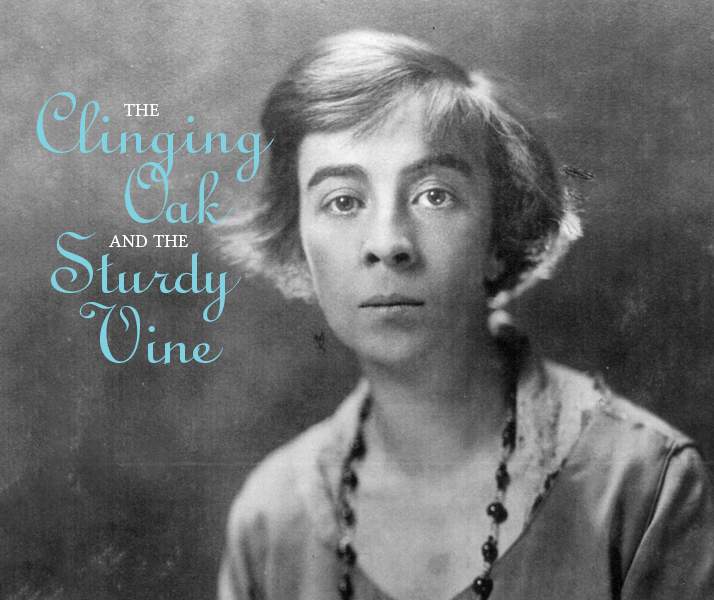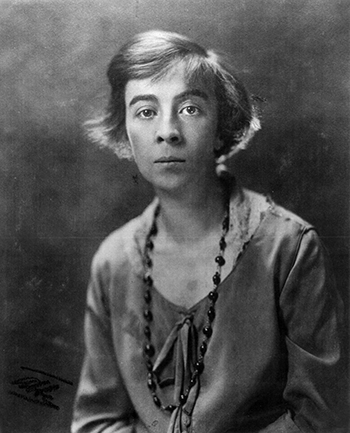
“The Clinging Oak and the Sturdy Vine”
Ruth Hale, a writer, feminist, and one of the founders of the Algonquin Round Table, received her early education at Hollins. She is one of three women about whom Susan Henry writes in Anonymous in their Own Names.

Ruth Hale was among the many famous and fascinating women to attend Hollins. She entered Hollins Institute at age 13 (her name while here was Lilly Ruth Hale) and stayed two years, graduating in 1901. A determined, ambitious, and talented writer, Hale worked as a reporter, sportswriter, critic (according to The New York Times, she was the “first female movie critic”), and drama publicist. She was also a feminist and activist. She and her husband, Heywood Broun, one of America’s most popular and influential newspaper columnists during the 1920s and ’30s, were among the founding members of the Algonquin Round Table. Their son, Heywood Hale Broun, became a well-known CBS sports correspondent in the 1960s and ’70s.
E ach of the women profiled in Henry’s book contributed to the success of her husband, although their roles were largely ignored by the public and press. Hale “had always been a rebel and activist,” Susan Henry writes, and not only helped Broun form and improve his columns, but also “prodded and inspired him to be much braver at the typewriter, fostering his transformation into a crusader and defender of the underdog.” Doris E. Fleischman and her husband, Edward I. Bernays, helped found and form the field of public relations. Jane Grant and her husband, Harold Ross, started The New Yorker magazine.
ach of the women profiled in Henry’s book contributed to the success of her husband, although their roles were largely ignored by the public and press. Hale “had always been a rebel and activist,” Susan Henry writes, and not only helped Broun form and improve his columns, but also “prodded and inspired him to be much braver at the typewriter, fostering his transformation into a crusader and defender of the underdog.” Doris E. Fleischman and her husband, Edward I. Bernays, helped found and form the field of public relations. Jane Grant and her husband, Harold Ross, started The New Yorker magazine.
The following excerpt from Henry’s excellent book describes the Hale-Broun wedding, encapsulating both personalities in a few paragraphs. Hale had given in to Broun’s mother’s desire for a church wedding, but she had several nonnegotiable wishes of her own: She and Broun would not exchange wedding rings, she would not promise to obey her husband, and there would be no wedding music.
Entering the back of the church at which she had grudgingly agreed to be married, the bride heard the opening chords of Mendelssohn’s wedding march rumbling from the organ. The groom’s mother, who had broken her word and hired an organist, sat in her pew and smiled. Her smile dimmed when the bride did not appear. Instead, into the second chorus, a messenger tiptoed down the side aisle to Henrietta Brose Broun and informed her that the bride was not going to move until the music stopped.
Mrs. Broun resisted through another full repetition, then surrendered, dispatching the messenger to the organ loft. “In mid-bar the church was suddenly, eerily, silent and Ruth Hale came sternly down the aisle,” wrote her son, picturing a scene that had been described to him many times. “It was the purposeful tread of the crusader as she marched toward the passive, perspiring man who was distributing placatory smiles to everyone in view.”
The edited service proceeded as she had planned. The word obey was never uttered, no wedding rings were exchanged, and she left the church determined to remain Miss Ruth Hale. Yet she still felt, her son said, that “by agreeing to show up at a foolish place to go through an outmoded ritual, she had led the enemy to doubt her resolution.” At least the couple’s best man, wit Franklin Pierce Adams, offered the wedding guests an apt description of the two main characters in the drama they had just witnessed. He pronounced Heywood Broun and Ruth Hale “the clinging oak and the sturdy vine.”
Anonymous in Their Own Names was published by Vanderbilt Press (2012). This excerpt is reprinted with permission. The quotes from Heywood Hale Broun are from his book Whose Little Boy Are You? A Memoir of the Broun Family (New York: St. Martin’s, 1983).
